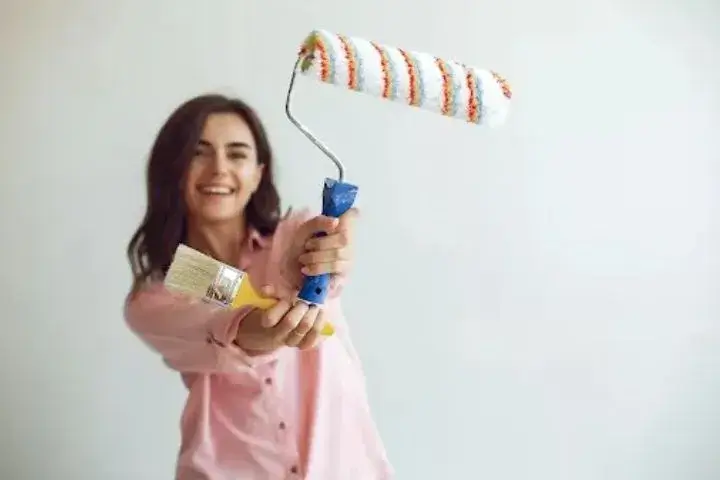Waterproof paint is not the first thing people think about when it comes to construction. Even though major factors like durability, functionality, and aesthetics are considered, people tend to forget about the waterproofing and the weight it holds in the durability of the construction. Waterproofing your property is a smart and imperative step in the process making your home or any other building a good place to be in. In this article, we will delve into the meaning, importance, and types of waterproofing paint. Additionally, we’ll offer suggestions on potential applications for the paint, guiding you on where it can be most effectively utilized.
Contents
What is Waterproofing Paint?
Waterproofing paint is designed to repel water, moisture, and condensation to protect your walls and other surfaces. Waterproofing paint prevents your surfaces from damage by creating a more durable and hygienic surface. Waterproof paint offers enhanced resistance, making it ideal for areas prone to high humidity, moisture, or direct contact with water. In contrast, traditional paints are more susceptible to damage in such wet conditions.
7 Reasons Why You Need Waterproof Paint
There is more to waterproofing paints than just protecting your surfaces from water. Here are some compelling reasons why you need waterproofing paint:
1. Reduced Risk of Structural Damage
Over time, prolonged exposure to moisture can weaken the integrity of building materials. This paint prevents water from seeping into walls, ceilings, and other critical structures. Waterproofing coatings are essential in preserving the strength and stability of a building, especially in areas prone to heavy rainfall or flooding. By mitigating water damage, it plays a pivotal role in prolonging the lifespan and safety of structures, including areas like waterproof bathroom walls.
2. Enhanced Durability
One of the most significant benefits of waterproofing paint is its ability to protect surfaces from water damage. Traditional paint types can absorb moisture, leading to peeling, cracking, and other forms of deterioration. Waterproofing, on the other hand, creates a barrier that repels water, preserving the integrity of surfaces for longer periods. This durability is particularly crucial for exterior walls, which are constantly exposed to the elements.
3. Mold and Mildew Resistance
In areas prone to dampness, such as bathrooms and basements, the growth of mold and mildew is a common concern. These fungi pose health risks, unsightly stains, and also cause damage to the surfaces. This paint contains antimicrobial properties that prevent the growth of mold and mildew, ensuring a healthier and cleaner environment.
4. Improved Indoor Air Quality
Waterproofing paint contributes significantly to improved indoor air quality. By preventing the growth of mold and mildew, known to release spores and cause respiratory issues, the paint ensures a healthier indoor environment. This is particularly beneficial in homes with children, the elderly, or individuals with asthma and allergies.
5. Versatility
The versatility of waterproof coating is another reason for its growing popularity. It is not just limited to external walls or wet areas. Its application extends to a variety of surfaces, including concrete, wood, and metal, making it suitable for different parts of a building, from the roof down to the foundation.
6. Ease of Application
Modern waterproof coatings are designed to be user-friendly. They can be applied similarly to regular paints, requiring no special tools or techniques. This ease of application makes them accessible not only to professional contractors but also to DIY enthusiasts.
7. Cost-Effectiveness
While the initial cost of waterproof paint may be higher than regular paint, its long-term benefits make it a cost-effective choice. By preventing water damage, it reduces the need for frequent repainting and repairs, thereby saving money in the long run. Additionally, its longevity means less frequent application, which translates to savings in both materials and labor.
Types of Waterproof Paints
With the numerous advantages that waterproofing coatings have to offer, it becomes a necessity for everyone. However, it is important to choose the right type of paint for waterproofing, depending on your requirements. There are several types of waterproofing paints, each designed to address specific needs and surfaces.
1. Polymeric Waterproofing Paint
This type of paint is formulated with various polymers, making it highly effective in waterproofing applications. It provides a durable, flexible, and seamless membrane that is resistant to weathering, chemical degradation, and UV radiation. Polymeric waterproofing is commonly used on exterior surfaces, roofs, balconies, and areas where high elasticity and long-lasting waterproofing properties are required.
Our solution: Polyalk WP: Polymeric waterproofing coating
2. Acrylic Elastomeric Waterproofing Paint
Water-based and versatile, acrylic elastomeric paint is commonly used for both interior and exterior surfaces. It’s known for its quick-drying properties and resistance to weathering. With its elastic properties, this paint can stretch and return to its original shape, making it perfect for covering cracks and joints. It’s commonly used on exterior walls and surfaces that require a waterproof but flexible coating.
Our solution: SUNKOTE WP+ Acrylic Elastomeric waterproofing decorative coating
3. Polyurethane Waterproofing Paint
Polyurethane coatings provide a highly durable and flexible finish, making them suitable for surfaces that experience UV exposure or temperature changes. It’s often used on roofs, decks, and areas exposed to direct sunlight.
Our solution: SUNPROOF PU1K
4. Admixture for Waterproof Plaster
Used mainly on concrete and masonry surfaces and plasters. This is an admixture to render plasters waterproof and crack-free.
Our solution: SUNPLEX: Shrinkage compensating waterproof admixture for plaster
5. Epoxy Waterproofing Paint
Epoxy coatings are ideal for floors and interior walls, as they are known for their durability and strong adhesion. These coatings are resistant to chemicals, stains, and abrasions, making it suitable for garages, warehouses, and industrial settings.
Conclusion
Waterproof painting stands as an important evolution in the industry of construction and painting. It plays a crucial role in maintaining the structural integrity of buildings, ensures healthier living and working environments, and aligns with the aesthetic and functional demands of modern architecture.
We, at Sunanda Global, are committed to providing the best waterproofing solutions, offering a wide range of products to meet the diverse needs of modern construction and painting. Whether you are a homeowner looking to protect your investment or a contractor seeking reliable solutions for your clients, Sunanda has suitable waterproofing solutions that can accommodate your requirements for your projects.


